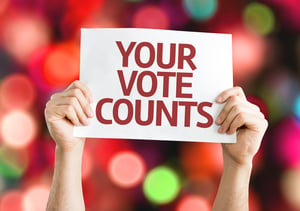 On Tuesday, November 3 the United States will hold its elections. These will elect not only the president but also members of the Senate, the House of Representatives, thousands of state officials across the country and decide hundreds of local referendums.
On Tuesday, November 3 the United States will hold its elections. These will elect not only the president but also members of the Senate, the House of Representatives, thousands of state officials across the country and decide hundreds of local referendums.
The American electoral system differs from Finnish system in almost every single aspect and can be confusing.
Let’s look at some of the key questions one may ask about the American election.
How can a candidate with less votes than their rival win the presidency?
In 2016 Donald Trump won the presidency although he received 63.0 million votes while Hillary Clinton received 65.9 million votes. This situation also occurred in 2000 when Al Gore received 544,000 more votes than George Bush yet lost the presidency.
The reason for this is the American electoral college system. In 2016 Donald Trump won the electoral college strongly with 306 votes to Clinton’s 232. In the electoral college system voters do not directly elect the President. Instead each state is given a certain number of electors. These are known as electoral votes and the number of a state’s electoral votes was originally designed to be related to its population. There are 538 electors in total. To win the election the successful candidate must win 270 of these. In 48 of the 50 states (except Maine and Nebraska which allocate their votes proportionately according to district) all the electoral votes are given to the candidate who receives the most votes in that state. This is known as the FPTP (first past the post) system or “winner takes all”.
A major issue is that, first, the system of political votes set out by the American constitution is now out of step with a more urban nation and the modern distribution of America’s population. The constitution’s voting system gives disproportionate votes to rural states compared to urban states. Thus Wyoming has one electoral vote for every 193,000 people while California has one electoral vote for every 727,000 people. This system is most evident in the Senate which allocates 2 senators per state irrespective of population. Therefore even though California has 69 times the population of Wyoming it has the same representation in the Senate. To give a Finnish perspective this would be as if the Sodankylä and Helsinki municipalities had the same number of MPs in the Parliament.
Second, the FPTP system also means millions of votes for a losing party effectively do not count, even in a very tight race. It creates a situation where politicians heavily concentrate on states or races evenly balanced between the parties where they have a chance to win. These are known as swing states or races. Swing states/races play a huge role in American politics and absorb up to 80% of all financing and advertising.
Meanwhile safe states/races that have a strong link to one party are often neglected or taken for granted.
New laws to tackle these democratic deficits have been proposed but according to the constitution they require a two thirds majority in congress. This is very unlikely to pass in the near future.
Why does it seem so complicated and time-consuming to vote in America?
The act of voting in America is a far more complicated and lengthy process than in Finland. First voting takes more effort as the right to vote for citizens is not automatic. Voters must register themselves, and voting rights can be removed for committing crimes, failing to pay fines, or technical problems in registration.
America also lacks standard personal identity documents. There is no standard record of addresses or confirmation of identity and all of this must be confirmed by the voters themselves in advance or at polling places.

In addition, an American faces far more choices to make on an election day than a Finn, who simply selects a single candidate. For example, in Seattle the voting ballot is tens of pages long. Voters must vote not only for the president, but also for 26 state positions (posts such as state auditor or insurance commissioner), choose
eight different judges and approve or reject 6 six local referendum questions (on issues such as tax rises or teaching sex education in schools). Most questions offer two options – a Democratic or Republican choice.
A crude characterisation could be to say that a Finn has to make one choice from 200 candidates, and an American has to make 100 choices with two candidates for each.
Here is a link to the 2020 Seattle voting pack showing the range of issues and choices a typical American has to decide on election day: https://www.sos.wa.gov/_assets/elections/voters-guide/2020/--ed05king-seattlearea.pdf
What is the forecast for the election and what are the points to look out for?
Current polling in the presidential election places the Democratic candidate Joe Biden around 10 percentage points ahead of President Trump.
However, it should be pointed out that Hillary Clinton was around six points ahead of Donald Trump in national polls in 2016 and yet went on to lose the election.
In America the key swing states and their electoral college votes are all important on election night. From a Democratic perspective these are most importantly the states that Trump won by less than 1% in 2016 - Michigan, Wisconsin, and Pennsylvania. If Biden held the Democratic 2016 states and won these 3 states alone with a swing of 1% it would place him on 272 votes and narrowly take the presidency. If the swing to the Democrats was larger, up to 5%, Biden would win states such as Florida, North Carolina, and Arizona. If there was a very strong democratic result, known as a “blue wave”, with a swing of up to 10%, that could involve the democratic gain of Georgia, Ohio, Iowa, or even Texas. The polling site 538.com currently rates a Biden victory at a 87.5% chance.
From a Republican perspective it is vital to hold on to states won in 2016, particularly Florida with 29 electoral votes and Pennsylvania with 20. The Trump campaign has spent almost half its tv advertising budget on these two states. If President Trump does well with a 0-5% swing he could make gains taking the narrowly democratic states of Minnesota, Colorado, Nevada, or New Hampshire. The polling site 538.com currently rates a Trump victory at a 12.5% chance.

Members of the House of Representatives, the lower chamber of Congress, are also up for election on November 3rd. The House of Representatives is currently controlled by the Democrats. Out 435 seats there are currently 232 Democrat, 197 Republican, 6 other or vacant. Most polls predict that the Democrats will maintain control of the House of Representatives. The polling site 538.com currently rates a Democrat victory at a 96% chance.
The other crucial election finalising on November 3 is the election for the Senate, the higher chamber of Congress. Not all Senate positions are up for election (only 35 out of 100) but of those that are being elected there are around 10 strongly competitive races. Republicans currently control the Senate 53 to 47. Democrats could take control of the Senate by winning 3 extra Senate seats if they take the presidency (as the Vice President has the casting vote in a 50-50 Senate tie) or 4 extra Senate seats if they do not take the presidency. Republicans hope to hold on to their seats and retake a Senate seat in Alabama.
Particular Senate races to watch are in Arizona, Iowa, Georgia, Alabama, Maine, North Carolina, and Colorado.
Sources:
www.senate.gov,
www.whitehouse.gov
http://www.npr.org
https://www.nytimes.com
https://projects.fivethirtyeight.com/2020-election-forecast/
https://www.270towin.com
https://www.sos.wa.gov/_assets/elections/voters-guide/2020/--ed05king-seattlearea.pdf
To help you follow the election please download our PowerPoint presentation of the US electoral system: the branches of government, electoral college, and a swing state forecast.
More of Claire´s blogs here.





